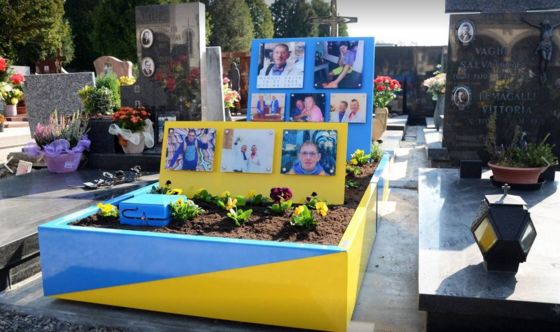
This is the grave of Carlo Annoni, a 61-year-old nurse and gay rights campaigner. He is buried in the cemetery of Mariano Comense, in Como, Italy.
His grieving husband chose a bright memorial, saying he wanted "something that speaks of life, and joy - love". But now critics have branded it a vulgar atrocity.
Andrea Ballabio, a local councillor for the Forza Italia party, said of the tomb: "No gender discrimination, but that grave is a punch in the eye - almost an insult to the other deceased and their loved ones who go to the cemetery."
He wants a strict "colour plan" to dictate what tombs in the cemetery look like - to the anger of Mr Annoni`s friends.
The row exposes a divide about respect for the dead, and what exactly that means. Some might see rainbow mausoleums as too showy, but is banning them a reasonable response? Surely it is a personal choice how we honour our lost loved ones?
Why are graves grey anyway?
Historically, grey gravestones became traditional in Europe because limestone, sandstone and slate were what regional stonemasons had available.
But nowadays the market is full of black marble, thanks to imports from China.
Professor Douglas Davies, director of the Centre for Death and Life Studies at the University of Durham, says that when people want something more colourful, it is usually expensive and hard to obtain.
But he has noticed a rise in tombstones with a touch more personality.
"It extends into things like having gravestones cut with a football motif," he says. "I was looking at one recently of a traveller Gypsy family, with big horses built into the gravestone - a remarkable structure. The building of lifestyle into death-style in headstones is, I think, a dramatically increasing trend."
Corrado Spanger, Mr Annoni`s partner of 36 years, told the BBC he wanted "a happy and colourful grave to express a sentiment of love and devotion".
"The colours also give the impression that Carlo`s life goes on somewhere else, leaving me with the impression that we are not truly separated."
And while it might not please everyone in Italy, his approach fits perfectly with traditions elsewhere in the world.
These countries love a colourful tomb
In Mexico, locals remember the departed through a three-day carnival of music and colour - the world-famous Día de los Muertos, or Day of the Dead.
Tombs are festooned with flaming marigolds, and the markets stock up on candied skulls, ghouls and coffins.
At home and in the cemeteries, private altars are heavy with flowers, candles, and the favourite foods of loved ones to encourage their spirits to visit.
Foreigners may find this upbeat attitude to remembrance alien, or even gruesome. But in parts of Latin America, it makes sense to toast the dead with a party.
"I would expect any Catholic country with a strong folk religion and where the lifestyle is colourful to have that reflected in their cemeteries," observes Prof Davies.
In Ghana too, post-mortem fashion is more daring. In the capital, Accra, "fantasy coffins" come in extraordinary shapes, including eagles, jeeps, cocoa pods, and scantily clad women.
Coffins here are seen as a status symbol - and a way to evoke the dead person`s life, loves and sense of humour.
So, are most of us just being boring?
It is hard not to smile at the sight of an exuberant bird-shaped coffin, but that level of decor is not for everyone. Some consider it selfish on a permanent memorial, saying it disrupts mourners who prefer an atmosphere of quiet contemplation.
Psychologist Dr Sally Austen tells the BBC that grief can make us keener on conformity, as we feel adrift and yearn to be anchored by something established. Something like a conventional, dark-coloured headstone, for example.
"As we go towards death, we start behaving in a way that is more scared and worried," she says. "And as if somewhere, someone who is more knowledgeable and powerful is going to expect us to behave."
So we are taking comfort in not standing out? Perhaps, she says.
"I think it`s old-school: [We think] other people have got this covered, this is what you do. This is what`s reliable and safe, and this is how I too can be held, in a psychological way, by tradition and procedure."
Despite this, Mr Spanger says most people in Como are unbothered by his husband`s striking tomb. For him, the "more is more" approach to memorials just makes sense.
"Politicians who want to suppress colour in our cemeteries go against religious culture, which celebrates death as the passage to new life," he says, "and also against non-religious culture, which wishes to remember a deceased person with happy memories from the time we shared."
Whatever the local council decides about future graves, Mr Spanger could not be happier with his choice: part garden, part photo gallery, a Technicolor monument to love.


0 comments:
Post a Comment